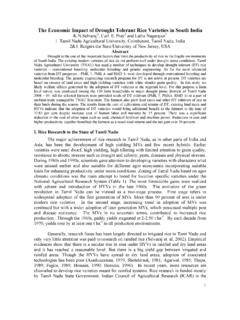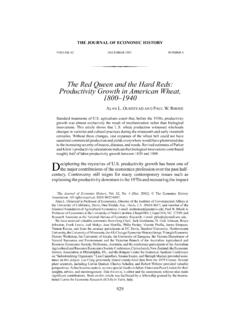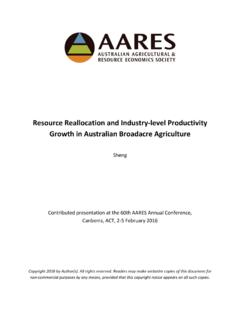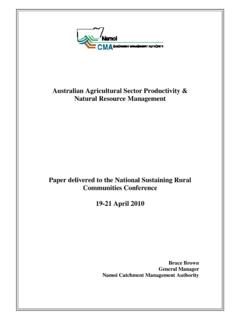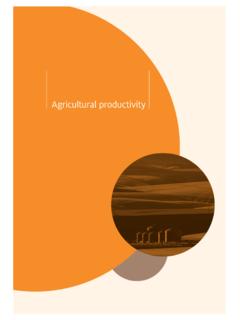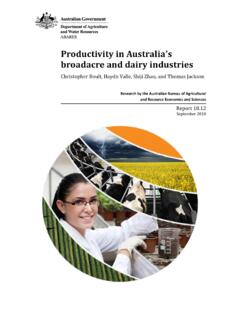Transcription of The Future Productivity and Competitiveness Challenge for ...
1 Contributed paper prepared for presentation at the 57th AARES Annual Conference, Sydney, New South Wales, 5th-8th February, 2013 The Future Productivity and Competitiveness Challenge for australian Agriculture John Mullen and Mick Keogh Adjunct Prof., Charles Sturt University australian Farm Institute ii Copyright 2013 by John Mullen and Mick Keogh. All rights reserved. Readers may make verbatim copies of this document for non-commercial purposes by any means, provided that this copyright notice appears on all such copies. 3 The Future Productivity and Competitiveness Challenge for australian Agriculture John Mullen and Mick Keogh Adjunct Prof., Charles Sturt Univ. australian Farm Institute Abstract The objective of this paper is to review likely trends in key drivers of Productivity with a view to suggesting the rate of Productivity growth that is likely to be required to maintain the Competitiveness of australian agriculture both within the australian economy and relative to the agricultural sectors of other economies.
2 The paper also canvasses prospect for achieving this level of Productivity performance over the period to in agricultural Productivity has slowed over the last two decades and a significant proportion of this slowdown in growth can be attributed to the stagnation in public investment in agricultural R&D since the late 1970s. The prospect that rate of growth of TFP could stay at less than rather than recover to a long term rate of is obviously quite concerning for the Future Competitiveness of agriculture both domestically and internationally. It would seem that to maintain TFP growth in the per year range, investment in agricultural R&D has to be returned to a level of of agriculture s GVP (or 5% of GDP), a major Challenge for government and industry. Keywords: Productivity , R&D investment; Competitiveness 4 Introduction The objective of this paper is to review likely trends in key drivers of Productivity with a view to suggesting the rate of Productivity growth that is likely to be required to maintain the Competitiveness of australian agriculture both within the australian economy and relative to the agricultural sectors of other economies.
3 The paper also canvasses how this level of Productivity performance might be achieved over the period to 2030. This paper is the lead paper in a set of six commissioned by the australian Farm Institute to explore the scope of the Productivity Challenge facing australian agriculture, and identify specific technologies and initiatives that could realistically assist the sector to attain the levels of Productivity growth that are likely to be required in the Future (Mullen et al., 2012, ). The other papers examined prospects for R&D and extension in plant, animal, and natural resource systems, and in key inputs such as energy, water, machinery and human capital to meet this Productivity Challenge . A return to good seasons, strong commodity prices and rapid economic growth in developing countries where income per capita and population are rising are among factors suggesting a very positive outlook for australian agriculture over the next twenty to thirty years.
4 This could lead to some complacency amongst farm business managers and policymakers about the continuing importance of Productivity growth to maintaining the Competitiveness of the sector. Such complacency is misplaced, as there is strong evidence globally that major developing nations are investing heavily in agriculture, and other sectors of the australian economy are also experiencing strong growth and out-competing australian agriculture for scarce resources. This confirms that while the outlook is positive, australian agriculture faces increased competition in international markets and increased competition for essential resources within Australia. A resumption of strong Productivity growth is the only realistic option available to the sector to respond to both these challenges.
5 Productivity growth has contributed strongly to growth in output in australian agriculture, as is highlighted in Figure 1. It shows that in the absence of Productivity growth over the past sixty years, the current gross value of production for the australian agricultural sector would only be approximately A$12 billion per annum, rather than more than $40 billion. It also highlights that more than 70% of the value of agricultural production in 2010 could be attributed to past Productivity growth , based on estimates that the average rate of Productivity growth in australian agriculture has been 2% per annum since 1953. 5 Figure -1: The value of Productivity growth (2%) to australian agriculture, 1953 2010 (A$2010). Source: Derived by the author from ABARES data in australian Commodity Statistics Whilst this past performance by the sector is impressive, there is growing concern that the rising value of the australian dollar and the strength of the mining sector threaten the Future Competitiveness of australian agriculture.
6 In addition there is evidence that Productivity growth has slowed, not just as a result of poor seasons but also because of declining levels of public investment in agricultural R&D. There are also concerns that growth in agricultural Productivity may be eroded by accelerating climate change, which some expect will impact on australian agriculture to a greater degree than on other agricultural exporters. While the focus of this discussion is on Productivity , it should be borne in mind that farmers are more interested in profitability. Productivity is a key contributor to growth in profitability but its contribution is modified by trends in the terms of trade (the ratio of prices farmers receive for outputs to prices paid for inputs) experienced by farmers (O Donnell 2010). This paper first examines the concept of Productivity and defines its components, before discussing issues surrounding the measurement of Productivity .
7 The paper then reviews historical trends in Productivity , including work by ABARES to derive an estimate of Productivity growth where the effects of climate variability have been removed. Then, follow sections reviewing prospects for potential major drivers of Productivity growth in agriculture including climate change (section 4); trends in Productivity and prices in other sectors of the economy particularly the resources sector (section 5), and the role of investment in agricultural research, development and extension (RD&E) in maintaining Productivity growth (section 6). Concluding comments are made in Section 7. - 10,000 20,000 30,000 40,000 50,000 60,0001953195619591962196519681971197419 7719801983198619891992199519982001200420 072010$mReal GVP Without Productivity GrowthReal GVP From Productivity growth 6 Key Productivity Concepts Calculation of rates of Productivity growth .
8 Economists define Productivity as the ratio of the volume of outputs to the volume of inputs for a particular production system or activity. Productivity growth is therefore the change in this ratio over time. In the case of a single output and a single input, these ratios are akin to a growth in crop yield per hectare or growth in animal product per hectare. However in the normal multi-output, multi-input agricultural production environment, crop yield or livestock production per hectare are only partial measures of the Productivity (often referred to as measures of partial factor Productivity (PFP)) of the farm, and can be a poor indicator of changes in Productivity when measured at a whole farm level. An improvement in wheat yield may not provide a sound indication of changes in whole farm Productivity if the use of inputs has changed or if the change in wheat yields is associated with other changes the farming system (such as a the introduction of another crop in the rotation).
9 Total factor Productivity (TFP), which attempts to measure gains in the efficiency with which all inputs are combined to produce all outputs1 can be represented as: ,,,/ntmsms ntms ntms ntntmsqqTFPQXxx where TFP is an index of the change in Productivity which can be either for different time periods for a collection of farms or different farms in the same time period but here it is defined as between firm n in period t and firm m in period s, q is output quantity, x is input quantity and Q and X, like TFP are indices of change (using notation from O Donnell, 2010). There is a large literature (O Donnell 2010) about the various functions which may be used to construct these measures of aggregate outputs, inputs and TFP and their index number properties, which will not be reviewed here.
10 However in approximate terms inputs and outputs are aggregated using prices to derive measures of total cost and total revenue. Prices are held constant between farms or time periods to so that the aggregates reflect changes in quantities. Clearly the accuracy of any measure of TFP depends on the accuracy of the data for inputs and outputs. One source of bias arises when the changes in the quality on inputs and outputs go unmeasured. The quality of land may decline because more marginal land is being used or because its nutrient status is being degraded. Farm labour may be improving because of higher educational attainments. Farm products may be increasingly differentiated on quality grounds to meet users needs more closely. The extent of the bias arising from these problems is unknown.

